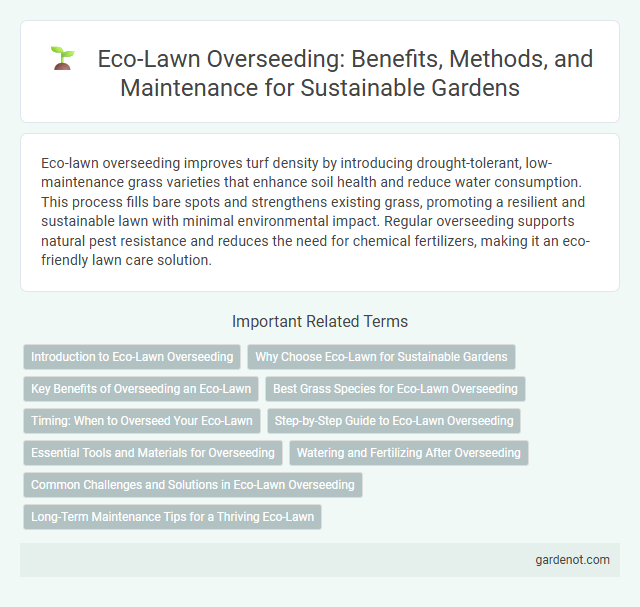Eco-lawn overseeding improves turf density by introducing drought-tolerant, low-maintenance grass varieties that enhance soil health and reduce water consumption. This process fills bare spots and strengthens existing grass, promoting a resilient and sustainable lawn with minimal environmental impact. Regular overseeding supports natural pest resistance and reduces the need for chemical fertilizers, making it an eco-friendly lawn care solution.
Introduction to Eco-Lawn Overseeding
Eco-lawn overseeding involves the strategic introduction of eco-friendly grass seed blends to revitalize and enhance existing lawns with drought-resistant, low-maintenance species. This process improves lawn density, reduces water consumption, and minimizes the need for chemical fertilizers and pesticides, promoting sustainable landscaping. Eco-lawn overseeding supports biodiversity by fostering a habitat for beneficial insects and pollinators, contributing to a healthier ecosystem.
Why Choose Eco-Lawn for Sustainable Gardens
Eco-Lawn overseed uses drought-tolerant grass varieties that reduce water consumption by up to 50%, promoting sustainable garden practices. Its natural seed coatings improve germination rates without harmful chemicals, supporting eco-friendly landscaping. Choosing Eco-Lawn minimizes environmental impact while maintaining lush, resilient lawns with reduced maintenance.
Key Benefits of Overseeding an Eco-Lawn
Overseeding an eco-lawn enhances turf density by introducing drought-resistant grass varieties, which improves soil erosion control and reduces water consumption. It promotes a healthier, more resilient lawn that requires fewer chemical fertilizers and pesticides, contributing to sustainable lawn care. Enhanced biodiversity from overseeding supports local ecosystems by attracting beneficial insects and pollinators.
Best Grass Species for Eco-Lawn Overseeding
The best grass species for eco-lawn overseeding include fine fescues such as creeping red fescue, chewings fescue, and hard fescue, which are drought-tolerant and require minimal maintenance. These species enhance soil health by promoting deep root systems and reducing the need for fertilizers and irrigation. Incorporating legumes like white clover in overseeding blends improves nitrogen fixation, further supporting sustainable turf growth in eco-lawn applications.
Timing: When to Overseed Your Eco-Lawn
The optimal timing to overseed your eco-lawn is during early fall or early spring when soil temperatures range between 50degF and 65degF, promoting seed germination and root development. Overseeding in these periods ensures young grass establishes before extreme heat or frost, enhancing lawn density and resilience. Avoid overseeding during summer heat or winter dormancy to prevent poor seed survival and patchy growth.
Step-by-Step Guide to Eco-Lawn Overseeding
Eco-lawn overseeding involves preparing the soil by mowing the existing lawn short and removing debris to ensure seed-to-soil contact. Spread a high-quality, drought-tolerant eco-lawn seed blend evenly across the area, focusing on species like fine fescues and native grasses for sustainable growth. Water the overseeded lawn lightly but consistently daily for the first two to three weeks, maintaining moisture without causing runoff to encourage germination and strong root development.
Essential Tools and Materials for Overseeding
Essential tools and materials for eco-lawn overseeding include a high-quality overseeder or spreader, compatible with seed types designed for eco-friendly turf such as drought-resistant grass varieties and clover blends. Proper soil preparation requires a dethatching rake or aerator to promote seed-to-soil contact and enhance germination rates. Additionally, organic compost or topsoil and a lightweight roller help improve seedbed conditions and ensure optimal eco-lawn growth and sustainability.
Watering and Fertilizing After Overseeding
Water your eco-lawn overseed lightly and frequently to keep the soil consistently moist, promoting seed germination and root development. Apply a balanced, slow-release fertilizer high in phosphorus to encourage strong root growth without encouraging excessive top growth. Maintain regular watering schedules until the new grass establishes, then gradually reduce frequency to encourage deep root systems that enhance drought tolerance.
Common Challenges and Solutions in Eco-Lawn Overseeding
Eco-lawn overseeding often faces challenges such as weed invasion, soil compaction, and improper seed-to-soil contact, which can hinder grass establishment. Using high-quality, drought-tolerant seed blends combined with aeration techniques improves soil structure and promotes healthy root growth. Regular monitoring and adjusting watering schedules ensure optimal moisture levels, enhancing seed germination and reducing the risk of moss and weed proliferation.
Long-Term Maintenance Tips for a Thriving Eco-Lawn
Eco-lawn overseed ensures dense turf that suppresses weeds and enhances soil health, requiring minimal water and fertilizer inputs for sustainable growth. Applying organic compost and mowing at higher heights maintains root strength and moisture retention, promoting drought resistance and reducing disease. Regular soil aeration and overseeding every few years rejuvenate the grass, supporting a resilient, eco-friendly lawn ecosystem.
Eco-lawn overseed Infographic

 gardenot.com
gardenot.com